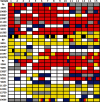Spatial Variation and Survival of Salmonella enterica Subspecies in a Population of Australian Sleepy Lizards (Tiliqua rugosa)
- PMID: 26092451
- PMCID: PMC4551259
- DOI: 10.1128/AEM.00997-15
Spatial Variation and Survival of Salmonella enterica Subspecies in a Population of Australian Sleepy Lizards (Tiliqua rugosa)
Abstract
The life cycles of many enteric bacterial species require a transition between two very distinct environments. Their primary habitat is the gastrointestinal tract of the host, while their secondary habitat, during transmission from one host to another, consists of environments external to the host, such as soil, water, and sediments. Consequently, both host and environmental factors shape the genetic structure of enteric bacterial populations. This study examined the distribution of four Salmonella enterica subspecies in a population of sleepy lizards, Tiliqua rugosa, in a semiarid region of South Australia. The lizards living within the 1,920-m by 720-m study site were radio tracked, and their enteric bacteria were sampled at regular intervals throughout their active seasons in the years 2001, 2002, and 2006. Four of the six subspecies of S. enterica were present in this population and were nonrandomly distributed among the lizards. In particular, S. enterica subsp. diarizonae was restricted to lizards living in the most shaded parts of the study site with an overstorey of Casuarina trees. Experiments undertaken to investigate the survival of S. enterica cells under seminatural conditions revealed that cell survival decreased with increased exposure to elevated temperatures and UV light. Among the three S. enterica subspecies tested, S. enterica subsp. diarizonae consistently had an average expected life span that was shorter than that observed for the other two subspecies. There was no indication in the data that there was any competitive dominance hierarchy among the S. enterica subspecies within individual hosts. Thus, the nonrandom distribution of S. enterica subspecies in this population of lizards appears to be driven by their different survival characteristics in the external environment.
Copyright © 2015, American Society for Microbiology. All Rights Reserved.
Figures




References
-
- Koeppel A, Perry EB, Sikorski J, Krizanc D, Warner A, Ward DM, Rooney AP, Brambilla E, Connor N, Ratcliff RM, Nevo E, Cohan FM. 2008. Identifying the fundamental units of bacterial diversity: a paradigm shift to incorporate ecology into bacterial systematics. Proc Natl Acad Sci U S A 105:2504–2509. doi:10.1073/pnas.0712205105. - DOI - PMC - PubMed
-
- Pauling BV, Wagner-Döbler I. 2006. Stream microcosm for investigating GEM impact on the autochthonous bacterial community in river water and sediment. Process Biochem 41:2129–2137. doi:10.1016/j.procbio.2006.06.023. - DOI
Publication types
MeSH terms
LinkOut - more resources
Full Text Sources

